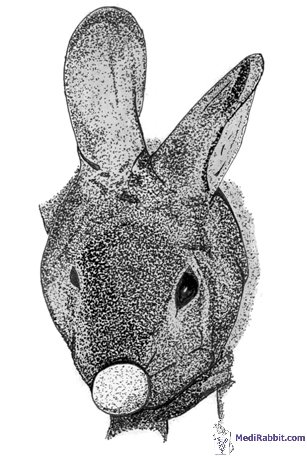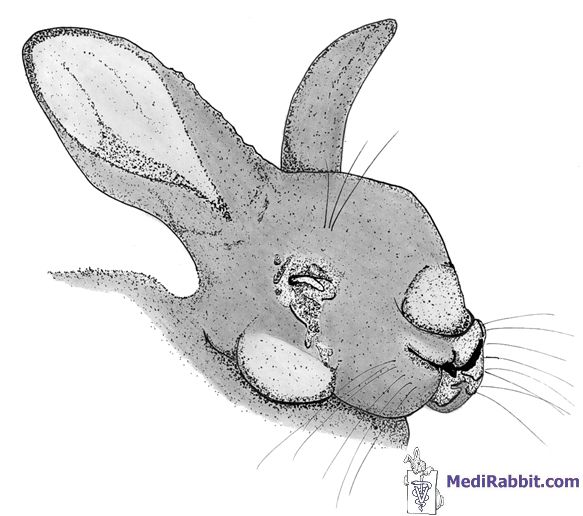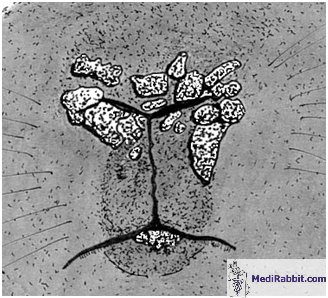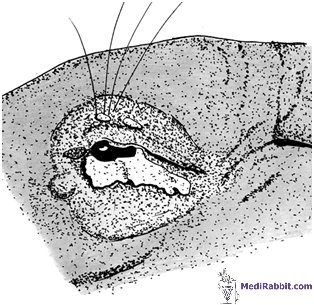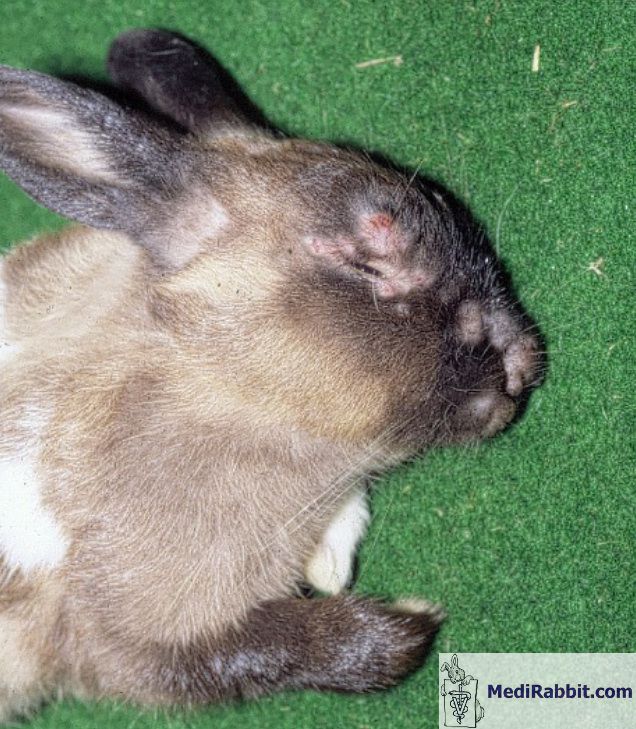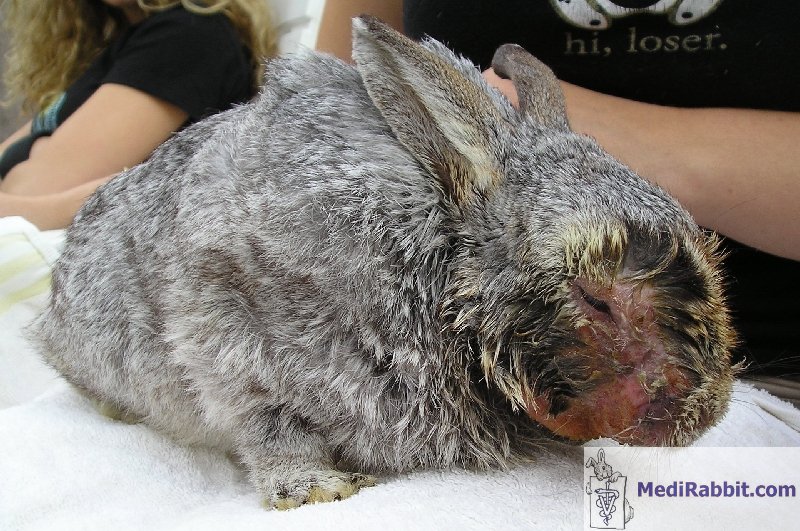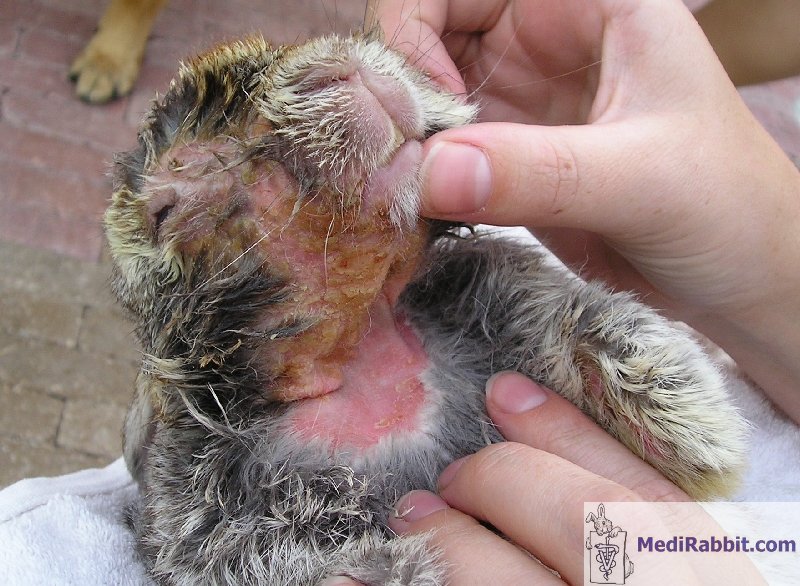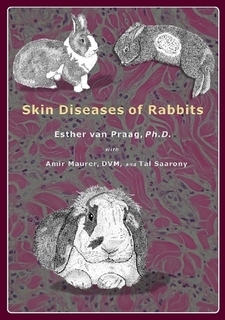うさぎのミクソマトーシス
Esther van Praag Ph.D. –
translated by Atsushi Fukuda
|
MediRabbit.comは皆様のご厚意で成り立っています。金額の多寡によらず、全てのご寄付に感謝申し上げます。またご寄付は世界のうさぎの医療と健康のための研究費として使わせて頂きます。ありがとうございます。 |
ミクソマトーシスは1896年、ウルグアイにて、Sanarelliにより発見されました。アメリカワタオウサギ各種(Sylvilagus sp.)における、散発性の致死的感染症の原因となる感染症です。原因ウイルスはアメリカ大陸全土に拡大し、一部の地域では風土病となりました(チリのアナウサギ、アメリカ西部のブッシュラビット)。
アナウサギ(Oryctolagus
cuniculi)がミクソーマウイルスに高い感受性を持つことが判明したのは、間もなくのことでした。感染すると、重度の皮膚膿瘍と感染が起こり、最終的には死亡します。1950年代にはミクソーマウイルスがオーストラリアの野生うさぎの個体数を減らす目的で、人為的に導入され、拡大しました。この作戦によりごく少数のウイルス耐性があった個体を除いて、ほぼ全ての野生うさぎが死滅しました。生き残ったうさぎが繁殖し、新たにオーストラリア全土へ広がりました。ヨーロッパでは、ミクソーマウイルスが急速に拡大し、一部の地域では風土病として、アナウサギの間で感染が維持されています。
ミクソーマウイルスに感受性のあるウサギ目の動物種としては、アナウサギ(Oryctolagus
cuniculi)、ヨーロッパノウサギ(Lepus europaeus)、ブラシウサギ(S. bachmani)、トウブワタオウサギ(S. floridanus)が挙げられます。
ミクソマトーシスはレポリポックスウイルス属ポックスウイルス科のウイルスが原因となる感染症です。レポリポックスウイルス属は、アメリカワタオウサギ属(Sylvilagus sp.)へ感染する類似ウイルスや、「ノウサギ線維腫ウイルス」などで構成されています。これら全てのウイルスが、皮膚結合組織の腫瘍化(線維腫)を起こします。様々なウイルス株が存在しています。一部は非常に病原性が高く(例:カリフォルニア州ルイジアナ、スタンダードラボラトリーで保有する株)、その他も慢性経過を辿ります。遺伝子研究から、ミクソーマウイルスとショープ線維腫ウイルスに関連があることが分かっています。 吸血性節足動物(ノミ、蚊、シラミ、ダニ)はこの感染症を効率よく伝搬する、機械的なベクターです。ウサギノミ(Spilopsyllus cuniculi)の口器に存在するミクソーマウイルスは、環境によらず100日以上も活性を保っていることが観察されています。さらに、うさぎ同士の皮膚ないし被毛の接触で感染が拡大すると推測されています。
臨床症状
ミクソマトーシスの経過は、ポックスウイルス感染症の典型的な経過を辿ります。皮膚へ接種されると、ウイルスは皮内と局所のリンパ節にて増殖を始めます。続いてウイルスは全身に播種されて行きます。ウイルスが全身に拡大し(ウイルス血症)、皮膚にも広がります。
最初の徴候は感染から3日後に現れます。眼瞼の腫脹(浮腫)に続き、口唇、生殖器にも腫脹が見られ、膿性結膜炎が起こります。病気が進行すると、失明します。通常、ウイルス感染から8から15日後にうさぎは死亡します。
慢性経過を辿る場合、最も目につく症状は、粘液腫(ミクソーマ)と呼ばれる皮膚腫瘍の形成です。粘液腫は耳、鼻、四肢に形成されます。これらの粘液腫は、ある程度の時間が経つと軽快します。慢性型ミクソマトーシスの弊害は、二次的な細菌感染です。パスツレラ属菌ないし黄色ブドウ球菌による肺炎がしばしば見られます。肺炎に続発し呼吸抑制(呼吸困難)が起こります。
診断
病状は感染したミクソーマウイルス株によりますが、通常は重症化し、ほぼ全例が死亡します。 臨床症状から診断は容易につきます。しかし、覚えておかなくてはいけないのは、スピロヘータ感染症(トレポネマ属感染により、うさぎの肛門周囲に病変を生じます)の初期症状が、ミクソマトーシスと類似しているということです。実際に、これらの感染症により形成される腫瘍病変も似た外観をしているので、スピロヘータ感染症とミクソマトーシスとを、注意深く鑑別しなくてはいけません。 ミクソマトーシスはまた、パスツレラ症のような上部気道感染とも鑑別が必要です。パスツレラ症ではミクソマトーシスと異なり、肛門周囲の腫脹は見られません。
慢性型ミクソマトーシスの症例では、バイオプシーを行って、ウイルスが存在するか調べることが勧められます。 治療
悪性度の高いミクソマトーシスに感染した場合、うさぎの助かる確率はほぼゼロです。人道的に安楽死させることが推奨されます。 治療を選択した場合、長期間に渡る集中治療が必要になります。罹患うさぎの周囲を暖かい環境(21-22℃)にすることが大切です。眼と耳を定期的にきれいにします。うさぎがそれなりの量の水を飲んでいたとしても、さらに出来る限り多くの水分と食餌をうさぎに与えるようにします。皮膚腫瘍は外科的に切除を行います。 不運なことに、二次的な合併症がしばしば出現します。一番多いのは、パスツレラ属菌ないしスタフィロコッカス属菌感染による、呼吸器障害と肺炎です。 慢性型ミクソマトーシスに罹患したうさぎは、自然治癒します。呼吸器合併症を避けるため、抗菌薬の投与を行っても良いでしょう。 ミクソマトーシスの常在地、そして野生うさぎやワタオウサギの間でミクソマトーシス感染が見られる地域では、定期的なワクチン接種によりペットうさぎのミクソマトーシスを予防できます。世界の全ての国々でワクチンが入手できる訳ではありません。 使用したワクチン、そのうさぎの年齢や品種により、ワクチン接種を受けているうさぎであっても中等度から重度のミクソマトーシス感染を起こすことがあります。稀なケースではありますが、うさぎを安楽死せざるを得ないこともあります。
うさぎのミクソマトーシスについての詳細な情報は、こちらをご参照ください。 “Skin Diseases of
Rabbits - 「うさぎの皮膚病」” 著:E. van Praag, A. Maurer
and T. Saarony, 408ページ、2010年 謝辞
うさぎのBucksの写真を提供して下さった、Denise Baartに深謝申し上げます。 Further
Reading
Best SM, Collins SV, Kerr PJ.
Coevolution of host and virus: cellular localization of virus in myxoma virus infection of resistant and susceptible
European rabbits. Virology. 2000; 277(1):76-91. Boag B.
Observations on the seasonal incidence of myxomatosis
and its interactions with helminth parasites in the European rabbit
(Oryctolagus cuniculus). J Wildl Dis. 1988;
24(3):450-5. Boag B, Lello J, Fenton A, Tompkins DM, Hudson PJ. Patterns of
parasite aggregation in the wild European rabbit (Oryctolagus cuniculus).
Int J Parasitol. 2001;
31(13):1421-8. Calvete C,
Estrada R, Villafuerte R, Osacar
JJ, Lucientes J. Epidemiology of viral haemorrhagic disease and myxomatosis
in a free-living population of wild rabbits. Vet Rec. 2002; 150(25):776-82. Chapple PJ, Lewis
ND. Myxomatosis and the rabbit flea. Nature. 1965;
207(995):388-9. Chapuis JL,
Chantal J, Bijlenga G. Myxomatosis
in the sub-antarctic islands of Kerguelen, without
vectors, thirty years after its introduction. C R Acad
Sci III. 1994; 317(2):174-82. Duclos P, Caillet J, Javelot P. Aerobic
bacterial flora of the nasal cavity of rabbits. Ann Rech Vet.
1986; 17(2):185-90. Edmonds JW, Nolan IF, Shepherd
RC, Gocs A. Myxomatosis: the virulence of field strains of myxoma virus in a population of wild rabbits (Oryctolagus
cuniculus L.) with high resistance to myxomatosis.
J Hyg (Lond). 1975;
74(3):417-8. Flowerdew JR, Trout
RC, Ross J. Myxomatosis: population dynamics of
rabbits (Oryctolagus cuniculus Linnaeus, 1758) and ecological effects
in the United Kingdom. Rev Sci Tech. 1992;
11(4):1109-13. Fountain S, Holland MK, Hinds
LA, Janssens PA, Kerr PJ. Interstitial orchitis with impaired steroidogenesis and
spermatogenesis in the testes of rabbits infected with an attenuated strain
of myxoma virus. J Reprod
Fertil. 1997; 110(1):161-9. Ghram A, Benzarti M, Amira A, Amara A. Myxomatosis
in Tunisia: seroepidemiological study in the
Monastir region (Tunisia). Arch Inst Pasteur Tunis.
1996; 73(3-4):167-72. Gorski J, Mizak
B, Chrobocinska M. Control of rabbit myxomatosis in Poland. Rev Sci
Tech. 1994; 13(3):869-79. Jiran E, Sladka M, Kunstyr I. Myxomatosis of rabbits--study of virus modification. Zentralbl Veterinarmed B. 1970;
17(3):418-28. Joubert L, Tuaillon P, Larbaigt G.
Serologic and allergologic relationship between
rabbit myxomatosis and fibromatosis viruses. Conglutination
reaction and homologous and heterologous hypersensitivity. Bull Acad Vet Fr. 1970; 43(6):259-76. Joubert L, Oudar J, Mouchet J, Hannoun C. Transmission of myxomatosis
by mosquitoes in Camargue. Preeminent role of Aedes
caspius and Anopheles of the maculipennis group. Bull Acad
Vet Fr. 1967; 40(7):315-22. Kerr PJ, Merchant JC, Silvers
L, Hood GM, Robinson AJ. Monitoring the spread of myxoma
virus in rabbit Oryctolagus cuniculus populations on the southern
tablelands of New South Wales, Australia. II. Selection of a strain of virus
for release. Epidemiol Infect. 2003; 130(1):123-33.
Kerr PJ, Best SM. Myxoma virus in rabbits. Rev Sci
Tech. 1998; 17(1):256-68. Lawton MP. Myxomatosis
vaccine. Vet Rec. 1992; 130(18):407-8. Licon Luna RM.
First report of myxomatosis in Mexico. J Wildl Dis. 2000; 36(3):580-3. Marcato PS, Simoni P. Ultrastructural researches on rabbit myxomatosis. Lymphnodal
lesions. Vet Pathol. 1977; 14(4):361-7. Marlier D, Mainil J, Linde A, Vindevogel
H. Infectious agents associated with
rabbit pneumonia: isolation of amyxomatous myxoma virus strains. Vet J. 2000; 159(2):171-8. Merchant JC, Kerr PJ, Simms NG,
Robinson AJ. Monitoring the spread of myxoma virus
in rabbit Oryctolagus cuniculus populations on the southern tablelands
of New South Wales, Australia. I. Natural occurrence of myxomatosis.
Epidemiol Infect. 2003; 130(1):113-21. Merchant JC, Kerr PJ, Simms NG,
Hood GM, Pech RP, Robinson AJ. Monitoring the
spread of myxoma virus in rabbit Oryctolagus
cuniculus populations on the southern tablelands of New South Wales,
Australia. III. Release, persistence and rate of spread of an identifiable
strain of myxoma virus. Epidemiol
Infect. 2003; 130(1):135-47. Nash P, Barrett J, Cao JX, Hota-Mitchell S, Lalani AS,
Everett H, Xu XM, Robichaud J, Hnatiuk
S, Ainslie C, Seet BT, McFadden G. Immunomodulation
by viruses: the myxoma virus story. Immunol Rev. 1999; 168:103-20. Omori M, Banfield
WG. Shope fibroma and rabbit myxoma factories:
electron microscopic observations. J Electron Microsc
(Tokyo). 1970; 19(4):381-3. Patterson-Kane J. Study of localised dermatosis in rabbits caused by myxomatosis. Vet Rec. 2003; 152(10):308. Patton NM, Holmes HT. Myxomatosis in domestic rabbits in Oregon. J Am Vet Med
Assoc. 1977; 171(6):560-2. Regnery DC. The
epidemic potential of Brazilian myxoma virus
(Lausanne strain) for three species of North American cottontails. Am J Epidemiol. 1971; 94(5):514-9. Regnery DC,
Miller JH. A myxoma virus epizootic in a brush
rabbit population. J Wildl Dis. 1972; 8(4):327-31. Robinson AJ, Muller WJ, Braid
AL, Kerr PJ. The effect of buprenorphine on the course of disease in
laboratory rabbits infected with myxoma virus. Lab
Anim. 1999; 33(3):252-7. Ross J. Myxomatosis
and the rabbit. Br Vet J. 1972; 128(4):172-6. Ross J, Tittensor
AM. The establishment and spread of myxomatosis and its effect on rabbit populations. Philos Trans R Soc Lond B Biol Sci. 1986;
314(1167):599-606. Ross J, Sanders MF. The
development of genetic resistance to myxomatosis in
wild rabbits in Britain. J Hyg (Lond).
1984; 92(3):255-61. Ross J, Tittensor
AM, Fox AP, Sanders MF. Myxomatosis in farmland
rabbit populations in England and Wales. Epidemiol
Infect. 1989; 103(2):333-57. Ross J, Sanders MF. Changes in
the virulence of myxoma virus strains in Britain. Epidemiol Infect. 1987; 98(1):113-7. Rothschild M. Myxomatosis and the rabbit flea. Nature. 1965;
207(2):1162-3. Sellers RF. Possible windborne
spread of myxomatosis to England in 1953. Epidemiol Infect. 1987 Feb;98(1):119-25 Shepherd RC. Myxomatosis: the occurrence of Spilopsyllus
cuniculi (Dale) larvae on dead rabbit kittens. J Hyg
(Lond). 1978; 80(3):427-9. Shepherd RC, Edmonds JW. Myxomatosis: the release and spread of the European
rabbit flea Spilopsyllus cuniculi
(Dale) in the Central District of Victoria. J Hyg (Lond). 1979; 83(2):285-94. Sobey WR, Conolly D, Haycockp, Edmonds
JW. Myxomatosis. The effect of age upon survival of
wild and domestic rabbits (Oryctolagus cuniculus) with a degree of genetic
resistance and unselected domestic rabbits infected with myxoma
virus. J Hyg (Lond).
1970; 68(1):137-49. Sobey WR, Conolly D. Myxomatosis: passive
immunity in the offspring of immune rabbits (Oryctolagus cuniculus)
infested with fleas (Spilopsyllus cuniculi Dale)
and exposed to myxoma virus. J Hyg (Lond). 1975; 74(1):43-55. Torres JM, Sanchez C, Ramirez MA,
Morales M, Barcena J, Ferrer J, Espuna
E, Pages-Mante A, Sanchez-Vizcaino JM. First
field trial of a transmissible recombinant vaccine against myxomatosis and rabbit hemorrhagic disease. Vaccine.
2001; 19(31):4536-43. Trout RC, Ross J, Fox AP. Does myxomatosis still regulate numbers of rabbits (Oryctolagus
cuniculus Linnaeus, 1758) in the United Kingdom? Rev Sci
Tech. 1993; 12(1):35-8. Werffeli F.
Observations on the appearance of a clinically atypical manifestation of myxomatosis in wild and domestic rabbits. Schweiz Arch Tierheilkd. 1967;
109(1):9-16. Williams RT, Dunsmore JD, Parer I. Evidence
for the existence of latent myxoma virus in rabbits
(Oryctolaqus cuniculus (L.)). Nature.
1972; 238(5359):99-101. Wunderwald C, Hoop
RK, Not I, Grest P. Myxomatosis
in the rabbit. Schweiz Arch Tierheilkd.
2001; 143(11):555-8 Zuniga MC.
Lessons in D tente or know thy host: The immunomodulatory gene products of myxoma
virus. J Biosci.
2003; 28(3):273-85. |
e-mail: info@medirabbit.com



